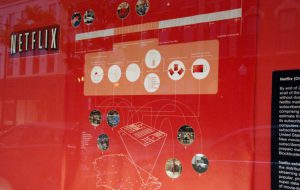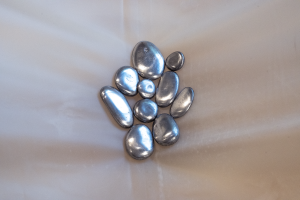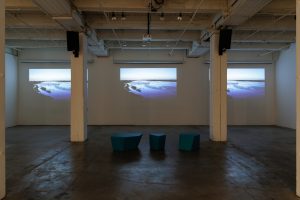File Type is a show currently on view at Gallery 400, which attempts to move beyond the general realm of “digital art” into a more nuanced exploration of the many iterations of commonly used files types such as .jpg, .pdf and .tiff. I had a chance to meet up with the curators of the show, Chaz Evans and Lorelei Stewart, at Gallery 400. We discussed the relevance of approaching new media with more specificity and I was able to uncover some of the ideas the artists were working with and the not-so-visible expressions of file type within their work.

Jennifer Nalbantyan: First, can you both tell me a little bit of your background with Gallery 400 and how long you’ve been curating?
Chaz Evans: This will be the first show that I’ve been able to participate in in a curatorial capacity at Gallery 400. I got my MA in Art History and I’m currently in the MFA program [at UIC] for New Media Art –I have one year left. I also work for Gallery 400.
Lorelei Stewart: I’m the Director of Gallery 400 and I’ve been here for 11 years.
JN: What makes file types unique from generalized “digital” or “electronic” media. What is their “cultural character” as you coin it?
CE: The idea was to append that kind of information– a file type alongside any kind of material list of an artwork. To start shifting perspectives in terms of materials of how a thing comes into being – the shapes, how it is represented and also to extract the exchanges or conversions. In the descriptions, we talk about the conversions of one file type to another file type, so even though we have static gallery objects, some of these are only one iteration of the process of how it’s developed.
For example, in the Todd Mattei and Wes Cline piece, the photo is only a record of the relationship and that relationship can be explained through the conversions of the file types. That’s only one example of how, when you start shaping the work with this perspective of how file types form, you get this other kind of information out of the object.
LS: I think, certainly we’re interested in the specificity of the file type—so if digital art is a big basket, we’re thinking, OK, here’s a particular question we’re interested in and thinking about whether we’re paying attention to the file type. What are the conditions around the file type, how is it being used by artists, and how is that reflective of how it’s used in broader culture?

JN: Are most of the artists in this show familiar with things like code or pretty well versed in the language of computers, or are some of them entering the issue from outside of that knowledge base?
CE: That’s a great question because the idea was to have diversity of different kinds of artistic practices and there’s definitely a whole spectrum of relationships to computers or electronic media. The point is that all of these kinds of practices are influenced by or have to engage with electronic media and specific file formats. But it runs all the way from Casey Reas’ work—he is the co-founder of his own coding language—to Chris Meerdo, who engaged in this topic but had to find a collaborator to write code so he could write a script to help him render all these pixels from the original Wikileaks file. And there are different skill sets that each artist has, different relationships to things like computer code or no relationship at all to computer code.
LS: With some artists, it’s clear that they know code and use the code. In Siebren Versteeg’s case, he wrote an executable program that creates this very complicated drawing, only in one iteration, and then it’s only printable one time—you can’t save it and you can’t print it again. So, that’s definitely the code that he wrote. Whereas Kristin Lucas does know code, but the piece of hers we’re showing has no code in it—the Refresh project in which she changed her name [from Kristin Sue Lucas to Kristin Sue Lucas]. She’s had a long history of working digitally and has great knowledge and skill in that arena, but with that piece [Refresh], the work itself is more about the conditions of the website and of our being as analogous to the website.
JN: How many of the artists are Chicago-based artists? Would you say that there is a particular flavor that Chicago artists bring to the table? For example, with Jon Cates’ piece being a visible part of the show and glitch art’s prominence in Chicago?
CE: About half of the artists are from Chicago. Yeah, I’m proud to select Jon as a representative of the Chicago glitch art scene, since he’s a great participant and supporter of that community. And while you have glitch art here, right around the corner you have lush textures of rendering 3D processing, which may be a contrasting aesthetic approach to the same thing.
LS: On the flip side of the question, so many of the artists who are in Chicago know the work of the artists who are not in Chicago, and they know it really well, so even the idea of location being the thing that connects the artists is really put into question.
JN: Were either of you involved in any of the production of these pieces, once in the gallery or otherwise?
CE: Well the Siebren Versteeg was a very involved production. It’s very labor intensive for any gallery that’s showing it. It takes about 4 to 6 hours for the drawing to generate and then there’s one moment to print it out as 64 squares on 64 pieces of paper. If you don’t print it at that right moment, it’s gone—the only way you can store the drawing is on the physical printout, and you can’t save it as an image file.
LS: Yeah, with some of the pieces, we just took the work right off of their website. But in Siebren’s case, that piece exists on discs, so he sent us the discs—there’s actually a black disc that generates the black drawing and a white disc that generates the white part of the drawing. So, Chaz had the disc run on the computer to generate the drawing and then printed it out.

JN: What’s your hope for any kind of discussion generated by this show?
LS: I certainly feel like work in this terrain could use more public viewing, and hopefully with this show—one of the things I like about the show is how much it has physical, formal work and conceptual work and this digital, virtual work in it. The divisions between media seem blurrier to me in this show and so that’s the kind of future I’d like to see—instead of having new media corralled off to the side, whether that’s in small galleries or big museums. Certainly, I want Gallery 400 to be more engaged in conversations around new media and its relevance in our lives and to the way that artists are working.
CE: Hopefully a specific set of questions have been raised, which asks what kind of output do these things, which are typically discarded as just “well, computer science did this and it’s irrelevant to creatives or the artistic process,” but realize that actually all these file types and all these compression standards and so forth were made by people and they make decisions which affect representation. So by throwing this into the mix, as something to consider alongside the artwork, we can open up the perspective in which to understand these processes as contingent. And if you’re interested as an artist or a creative agent to manipulate that, you have options regarding file types.
LS: There’s also a second question that I think the show asks about work that exists in virtual space and then work in the physical gallery. Instead of thinking about them as two poles that are separate from each other, I’m really interested in how the gallery is changed by the virtual and what new practices could happen in the gallery because of it. I don’t necessarily think that this show did those things, but I think it asked those questions. So, I could envision a project that’s about the relationship between things that exist virtually and things in the gallery and how they may be more like each other than separate.
File Type continues through July 30, 2011 at Gallery 400, located at 400 S. Peoria Street, Chicago, IL 60607.



